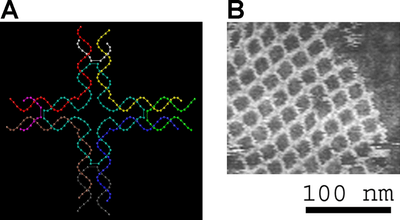Nanostructure

| Part of a series of articles on |
| Nanomaterials |
|---|
| Fullerenes |
| Nanoparticles |
|
|
A nanostructure is a structure of intermediate size between microscopic and molecular structures. Nanostructural detail is microstructure at nanoscale.
In describing nanostructures it is necessary to differentiate between the number of dimensions on the nanoscale. Nanotextured surfaces have one dimension on the nanoscale, i.e., only the thickness of the surface of an object is between 0.1 and 100 nm. Nanotubes have two dimensions on the nanoscale, i.e., the diameter of the tube is between 0.1 and 100 nm; its length could be much greater. Finally, spherical nanoparticles have three dimensions on the nanoscale, i.e., the particle is between 0.1 and 100 nm in each spatial dimension. The terms nanoparticles and ultrafine particles (UFP) often are used synonymously although UFP can reach into the micrometre range. The term 'nanostructure' is often used when referring to magnetic technology.
Nanoscale structure in biology is often called ultrastructure.
List of nanostructures
- GML nanofilm
- Icosahedral twins
- Nanocages
- Nanocomposite
- Nanofabrics
- Nanofiber
- Nanoflake
- Nanoflower
- Nanofoam
- Nanomesh
- Nanoparticle
- Nanopillar
- Nanopin film
- Nanoplatelet
- Nanoribbon
- Nanoring
- Nanorod
- Nanoshell
- Nanotip
- Quantum dot
- Quantum heterostructure
- Sculptured thin film
References
- ↑ M. Strong (2004). "Protein Nanomachines". PLoS Biol. 2 (3): e73–e74. doi:10.1371/journal.pbio.0020073. PMC 368168. PMID 15024422.